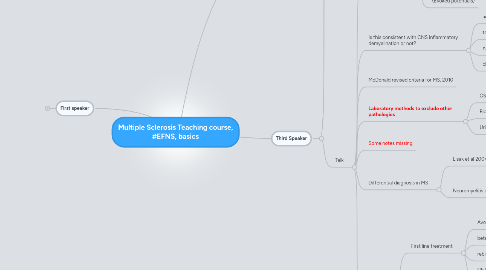
1. First speaker
1.1. Pathogenesis of MS Finn Sellebjerg Copenhagen, Denmark
1.2. Talk
1.2.1. Recent discoveries
1.2.1.1. Brain 2011, Haider
1.2.1.1.1. if you look at MS lesion w normal appearing white matter, areas can be highlighted where there's oxidative damage already
1.2.1.1.2. Oxidative changes and inflammation
1.2.1.1.3. Inflammation in MS subtypes
1.2.1.2. Recovery process
1.2.1.2.1. slide missed... nice research on this
1.2.2. Inflammatory demyelinating diseases
1.2.2.1. Peripheral nervous system
1.2.2.2. central nervous system
1.2.2.2.1. MS
1.2.3. Pathologyof MS
1.2.3.1. Classicalpathology
1.2.3.1.1. Mc Alpine's MS (1998)
1.2.3.1.2. Peterson et al, Ann Neurol 2001
1.2.3.1.3. Structure of myelin (node of ranvier)
1.2.3.1.4. Pathophysiology of MS notonly demyelination
1.2.3.1.5. Classical demyelinating lesion
1.2.3.2. immunopathogenesis
1.2.3.2.1. 15 years ago
1.2.3.2.2. Today: soo much more
1.2.3.2.3. Treatment
1.2.4. Etiology of MS: multi factorial
1.2.4.1. Ebers, Lancet Neurol 2008, IMSGC and WTCCC, Nature 2011
1.2.4.2. Environment
1.2.4.2.1. vitamin D
1.2.4.2.2. Smoking
1.2.4.2.3. infection
1.2.4.3. Genetics
1.2.4.3.1. HLA alleles
1.2.4.3.2. other "immune genes"
1.2.4.3.3. Other genes
1.2.4.4. Immunity
1.2.4.4.1. Adaptive
1.2.4.4.2. innate
1.2.5. PApers
1.2.5.1. Multiple sclerosis: a two-stage disease?
1.2.5.1.1. relapsing-remitting
1.2.5.1.2. secondary progression
1.2.5.1.3. influential papers
1.2.5.2. Is it true?
1.2.5.2.1. Secundary vs primary progressive MS
1.2.5.2.2. missing notes
1.2.5.3. Inflammation & degeneration.. or both?
1.2.5.3.1. Inflammatory demyelinasion
1.2.5.3.2. prediction was
1.2.5.3.3. However....
1.2.6. Clinical disease courses
1.2.6.1. New node
2. Second Speaker
2.1. Epidemiology and course of MS Christian Confavreux Lyon, France
2.2. Talk
2.2.1. The Facts
2.2.1.1. Frequency
2.2.1.1.1. 100-200/100000 incidence
2.2.1.2. distribution
2.2.1.3. demogrpahic characteristics
2.2.1.3.1. geographical distribution is subject to high variations
2.2.1.3.2. Davenport, 1921
2.2.1.3.3. Handbook of clinical neurology, Volume 47 on MS
2.2.1.4. MS prevalence in French farmers
2.2.1.4.1. the closer to equator the lower prevalence
2.2.1.4.2. Vukusic et al 2007, nj neurol neurosurg psychiat
2.2.1.4.3. north of France much higher prevalence than south part
2.2.1.5. MS prevalence in French General population
2.2.1.5.1. North east, high relative risk
2.2.1.5.2. Fromont et al brain 2010
2.2.1.6. Effect of migrations
2.2.1.6.1. Compston,
2.2.1.6.2. kahana et al j neurol 1994
2.2.1.6.3. Age-specific prevalence of MS ni Israel
2.2.1.6.4. AGe-specific prevalence of MS in Frest West Indies
2.2.1.6.5. moving early in life increases the risk
2.2.1.7. Some notes missed...internet connection
2.2.1.8. French cohort: sex-ratio
2.2.1.8.1. Female > male
2.2.1.9. Age of onset
2.2.1.9.1. French cohort of 30.000 patients
2.2.1.9.2. from 1950-2005: age of onset went up.. from 23 to 33
2.2.1.9.3. Female to male ratio: no of females relatively increases
2.2.1.10. Race and relative
2.2.1.10.1. Familial aggregation
2.2.1.10.2. Reference: McAlpine's MS 4th edition
2.2.1.10.3. Associated genes
2.2.2. Interpretation of the facts
2.2.2.1. Exogeneous factors
2.2.2.1.1. Geography
2.2.2.1.2. MS in migrants
2.2.2.1.3. Demographic changes
2.2.2.1.4. Familial aggregation
2.2.2.1.5. Twins
2.2.2.1.6. ?
2.2.2.2. Endogeneous factors
2.2.2.2.1. Geography
2.2.2.2.2. Familial aggegation
2.2.2.2.3. ?
2.2.2.3. Infections
2.2.2.3.1. Direct effects
2.2.2.3.2. Indirect effects
2.2.2.4. Ultraviolet exposure
2.2.3. Environmental suspects
2.2.3.1. Infections
2.2.3.1.1. hygiene hypothesis
2.2.3.2. chemico-physical environment
2.2.3.2.1. sun exposre
2.2.3.2.2. vitamin D
2.2.3.2.3. Contraceptive pill
2.2.3.2.4. jobb
2.2.3.2.5. tobacco
2.2.3.3. Life expectancy
2.2.3.4. Epigenetic
2.2.3.5. Also differential in gender
2.2.3.5.1. life expectancy
2.2.3.5.2. contraceptive pill
2.2.3.5.3. job
2.2.3.5.4. tobacco
2.2.4. Conclusion
2.2.4.1. multi factorial origin of risk for developing disease
3. Third Speaker
3.1. The management of MS Hans-Peter Hartung Dusseldorf, Germany
3.2. The diagnosis of MS
3.3. Talk
3.3.1. Making diagnosis:
3.3.1.1. History
3.3.1.2. Neurological exam
3.3.1.3. MRI (brain / spinal)
3.3.1.3.1. MRI
3.3.1.4. CSF analyses
3.3.1.5. (Evoked potentials)
3.3.2. Is this consistent with CNS inflammatory demyelination or not?
3.3.2.1. age of onset
3.3.2.2. temporal evolution of deficit (including recovery)
3.3.2.3. nature of deficit
3.3.2.4. clinical features which challenge a diagnosis of MS
3.3.3. McDonald revised criteria for MS, 2010
3.3.4. Laboratory methods to exclude other pathologies
3.3.4.1. CSF
3.3.4.2. Blood
3.3.4.3. Urine
3.3.5. Some notes missing
3.3.6. Differential diagnosis in MS
3.3.6.1. Lisak et al 2004
3.3.6.2. Neuromyelitis optica
3.3.6.2.1. wingerchuk et al, neurology 2006
3.3.6.2.2. Major criteria
3.3.6.2.3. Minor criteria
3.3.7. Therapy
3.3.7.1. First line treatment
3.3.7.1.1. Avonex
3.3.7.1.2. betaferon
3.3.7.1.3. rebif
3.3.7.1.4. Glatiramer
3.3.7.2. REGARD trial
3.3.7.3. BEYOND trial
3.3.7.3.1. Oçonnor Lancet neurol 2009
3.3.7.4. Second line treatment
3.3.7.4.1. missed slide
3.3.7.5. COmie et al 2009, kappos et al 2006, jacobs et al NEJM 2000, kinkel et al neurology 2006, champions study group neurology 2006
3.3.7.6. MS therapy consensu group (MSTCG) immunotherapy in MS
3.3.7.6.1. Relapse therapy
3.3.7.6.2. Basic therapy
3.3.7.7. AFFIRM trial: phase III natalizumab, Lancet 2011, Hans Peter Hartung
3.3.7.8. Havrdovaet al Lancet Neurol 2009
